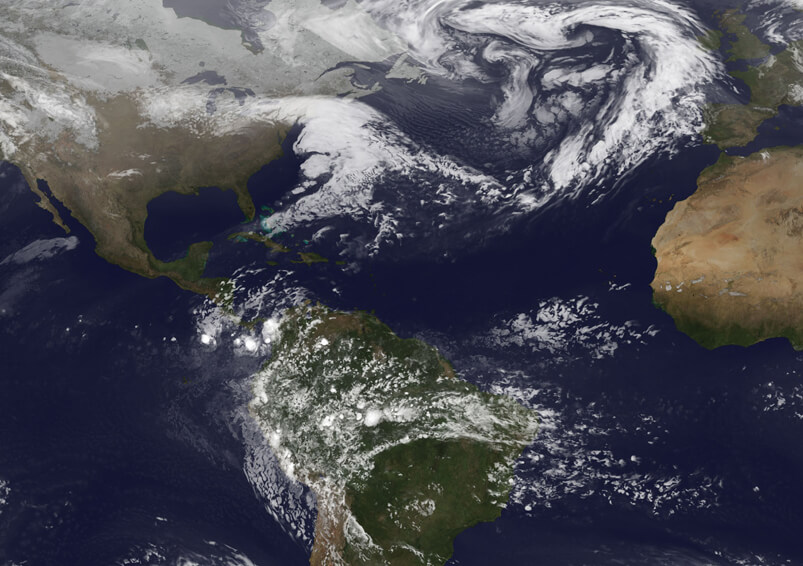What is the source of the energy of the giant spirits? How are they created? Why do they develop and grow? Prof. Gregory Falkovitz, from the Department of Physics of Complex Systems at the Weizmann Institute of Science, examines various theories in order to understand how these huge phenomena occur in the Earth's atmosphere

Huge wind systems illustrate to us, time after time, the complexity of the factors that influence the weather. But what is the source of the energy of the giant spirits? How are they created? Why do they develop and grow? Prof. Gregory Falkovitz, from the Department of Physics of Complex Systems at the Weizmann Institute of Science, examines various theories with the aim of understanding how these huge phenomena take place in the Earth's atmosphere. "The atmosphere is a very thin layer in relation to the size of the Earth," he says. "Naturally, we are mainly interested in what happens at an altitude of up to 10 kilometers. This is a layer that, in relation to the thickness of the entire atmosphere, can be seen as two-dimensional."
Prof. Falkovitz, as a theoretical physicist, developed a theoretical model of the processes that take place in this atmospheric layer. To test the model under controlled conditions, a friend of the experimental physicist Prof. Michael Shats from the Australian National University, in Canberra, built in his laboratory a desktop system that simulates the low atmospheric system (up to 10 km altitude). In this system, where water plays the role of air, he created oscillations - and waited.
Differences between the degree of absorption of solar radiation by the ground in different areas, and differences in the direct heating of the air by the sun in different areas, create temperature differences and, correspondingly, pressure differences. As a result, both vertical air movements and horizontal flows (winds) frequently occur in the atmosphere.
The scientists created similar phenomena in the controlled system in the laboratory, and obtained results that correspond to the predictions of the model developed by Prof. Falkowitz. It turns out that if a relatively small vertical movement takes place in a system where a strong horizontal movement (wind) is already taking place, a very large horizontal vortex will develop within a short time. "This is turbulence on a global scale," says Prof. Falkovitz. "Cotran can reach up to 1,000 and even 5,000 kilometers. Only satellite measurements can teach us about its full extent."
But the formation of the vortex is only the first step in the process. In the next step, after a certain period of time, a surprising phenomenon takes place. It turns out that the horizontal wind vortex, which relatively can be seen as two-dimensional, "suppresses" the vertical system (which originally caused its formation), and "draws" additional energy from it. Since the causes of the horizontal flow are still present, a new, and actually larger, horizontal flow is created, which also transfers its energy to the horizontal vortex. In this way, a kind of "growth engine" is created, which provides energy and causes a gradual growth of the horizontal vortex.
Love of construction workers
In 1984, shortly after receiving a PhD in physics from the Novosibirsk Institute of Nuclear Physics in the former Soviet Union, Prof. Gregory Falkovits, from the Department of Physics of Complex Systems at the Weizmann Institute of Science, turned to thinking about a rather prosaic matter: housing. At that time, and in that place, there was a severe shortage of built-up residential areas, and the waiting list for an apartment was long enough to be described as depressing. The young Dr. Falkowitz, in his position equivalent to that of a post-doctoral researcher, could expect something like ten years of waiting at least.
One evening, in a "steam" conversation with friends, a creative idea came up: to offer the National Academy of Sciences a deal that was hard to refuse: the young physicists would renovate the academy's residential buildings, and in return their waiting period for housing would be shortened. The proposal was accepted, the physicists hung from the roofs of the buildings in "Snapfling", sealed walls, plastered, painted and repaired gutters, but in the evening they could finally relax in their own modest apartments.

2 תגובות
Prof. Gregory Falkovitz is one of the most talented scientists working in Israel today. His general area of work is the study of turbulence, for which there are questions that physics has been trying to deal with for hundreds of years without success. Since Kolmogorov deduced the law of simulations regarding turbulence, very little significant work has been done in the field. In recent years, it was Gregory Falkowitz who showed the limitations of the law of turbulent simulations, when it is valid, when it is not, and how it can be extended. I think it would be highly recommended to hear more about Falkowitz's works.